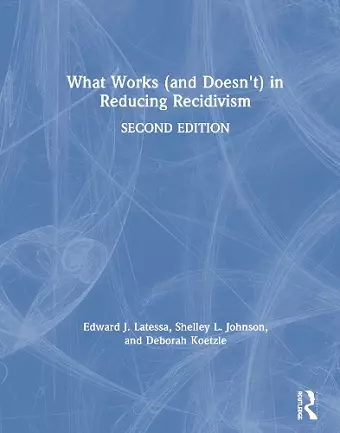What Works (and Doesn't) in Reducing Recidivism
Shelley Johnson author Edward J Latessa author Deborah Koetzle author
Format:Hardback
Publisher:Taylor & Francis Ltd
Published:16th Jul '20
Currently unavailable, and unfortunately no date known when it will be back
This hardback is available in another edition too:
- Paperback£48.99(9780367357214)

What Works (and Doesn’t) in Reducing Recidivism offers criminologists and students an evidence-based discussion of the latest trends in corrections. Experts Latessa, Johnson, and Koetzle translate the research and findings about what works and doesn’t work in reducing recidivism into understandable concepts and terms, presenting them in a way that illustrates the value of research to practice. Over the last several decades, research has clearly shown that rehabilitation efforts can be effective in reducing recidivism among criminal offenders, but it is clear that treatment is not a one-size-fits-all approach. Offenders vary by gender, age, crime type, and/or addictions, to name but a few ways, and these individual needs must be addressed by providers. Finally, issues such as leadership, quality of staff, and evaluation efforts affect the quality and delivery of treatment services.
While other texts have addressed issues regarding treatment in corrections, this text is unique in that it not only discusses the research on "what works" but also addresses the implementation issues faced as practitioners move from theory to practice, as well as the importance of staff, leadership, and evaluation efforts.
This book synthesizes the vast research for the student interested in correctional rehabilitation as well as for the practitioner working with offenders.
"Marshalling an impressive collection of applied research studies on correctional effectiveness, Latessa, Johnson, and Koetzle provide an analysis of the findings. Their conclusions clearly specifies what is effective and what is not in terms of reducing recidivism. Their work explodes myths concerning panaceas and 'common sense' political quick fixes to demonstrate how corrections can implement programs that work and re-establish the goal of rehabilitation. The book is a model to guide evidence-based practice in corrections."
Gennaro F. Vito, Professor of Criminal Justice, University of Louisville
"Every year, millions of offenders will be released from our jails and prisons. Ensuring their successful re-entry into the community and encouraging their prosocial behavior and positive contributions to society are in everyone's best interest. Thus, it is imperative that we develop a deep understanding of what works—and what does not work—within correctional settings. This book does just that. Written by the leading figures in corrections and treatment, this is a how to guide for students, academics, practitioners, and policymakers that provides evidence-based guidance on helping transform people's lives."
Alex R. Piquero, Ashbel Smith Professor of Criminology, The University of Texas at Dallas & Professor of Criminology, Monash University
"Correctional quackery has dominated correctional treatment for far too long. The authors provide a scientific pathway for effective correctional treatment."
Harry E. Allen, Professor Emeritus, Justice Studies Department, San Jose State University
ISBN: 9780367357207
Dimensions: unknown
Weight: 752g
320 pages
2nd edition